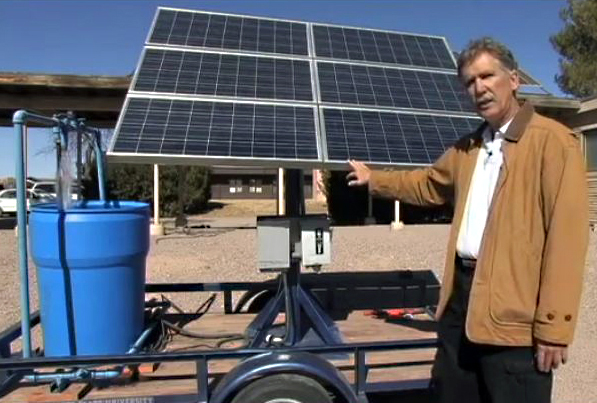Tool helps farmers utilize solar power

New Mexico State University College of Engineering Professor Tom Jenkins is developing tools to show New Mexico's farmers and ranchers how they can use one of our state's most plentiful resources, the sun, to access one of the most scarce, water.
In New Mexico, wells can range from 10 to 1,000 feet in depth.
"When you are 20 miles from the nearest electrical outlet, that makes things a little difficult," said Tom Jenkins, professor of engineering technology and head of the department's renewable energy program. "Solar power is a great option because it's so available in New Mexico where the sun shines nearly every day of the year. Wind is not as reliable, depending on location, and geothermal and hydroelectric sources are less viable options."
Jenkins has developed a computerized tool, the Solar Water Pumping Design Specification Spreadsheet, which can help farmers and ranchers with the basic process of designing a solar water pumping system that will help them determine feasibility and make implementation decisions.
Users can enter information about the depth of their well, its location, if it will be used for watering livestock, how many and what type of livestock, other daily water requirements, etc. The spreadsheet will recommend the volume of water needed and how much storage will be needed as reserve for cloudy days. The system will recommend a hardware layout for the given application, how many panels will be needed, pump and pipe size. The spreadsheet, available in both English and Spanish, also has an economic component that will help estimate how much a system might cost.
The ability to enter different values into the spreadsheet allows users the opportunity to investigate different scenarios before making final decisions on solar-powered water pumping system designs.
The project arose after Jenkins attended a presentation by the Cooperative Extension Service, which surveyed its agents serving the state's 33 counties about what kind of engineering assistance is needed by Extension clientele. The response was alternative sources of energy technology that would help them address the challenges associated with the availability of water.
The spreadsheet and associated documentation can be found at http://www.engr.nmsu.edu/outreach_solar.shtml.
Initially, Jenkins, along with fellow engineering technology professor Kenny Stevens, partnered with the College of Agricultural, Consumer and Environmental Sciences to create a series of short videos that promote renewable energy. The videos can be viewed at http://www.engr.nmsu.edu/outreach.professional.shtml.
Then, in the spring 2011 semester, Jenkins presented his ideas to engineering technology seniors as possible projects for their senior capstone design courses--the culmination of the engineering
curriculum at NMSU, requiring students to utilize knowledge and skills acquired throughout their coursework.
Lloyd Vigil and Christian Garces took on the Solar Water Pumping Design Specification Spreadsheet as their senior capstone project in the spring 2011 semester.
At the same time, Cody Anderson, Felicia Costales and Andres Galvan, under the tutelage of Craig Ricketts, associate engineering technology professor, designed and built a portable solar-powered water pumping demonstration unit that could be taken into the field. The unit can simulate pumping from depths up to 400 feet. It is outfitted with a small solar panel that collects heat energy from sunlight and converts it to electricity to power a high-pressure a submersible pump in a 50-gallon storage vessel. It is available for extension agents to demonstrate how solar power could be used to pump well water to the agricultural community.
Jenkins received funding from the Engineering New Mexico Resource Network and the New Mexico Space Grant Consortium to further develop the spreadsheet, which, in conjunction with the Cooperative Extension Service, was presented to agents in Corona, N.M as a short course in late November. It is hoped that extension agents use the spreadsheet to assist their clientele in the agricultural community.
Jenkins has applied for additional funding to continue developing the spreadsheet and hopes to release a second version of the spreadsheet with new features. He also is contemplating solutions for two other farming issues: water that freezes in the winter and water with high concentrations of dissolved minerals, particularly sulfur.
"My particular area of interest is in renewable energy," said Jenkins. "There is a lot of expertise throughout the College of Engineering that could be utilized for the benefit of the New Mexico agricultural community."
"The Engineering New Mexico Resource Network is committed to developing innovative approaches to help improve the quality of life for the residents of our state," said Ricardo B. Jacquez, dean of the College of Engineering.


